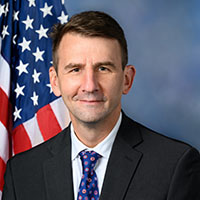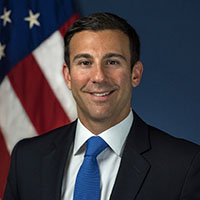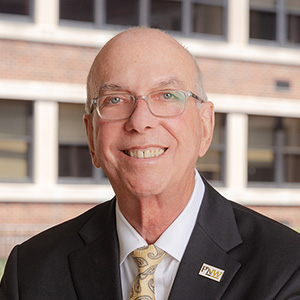Purdue University Northwest and industrial partners celebrate $10 million federal grant for steel decarbonization research
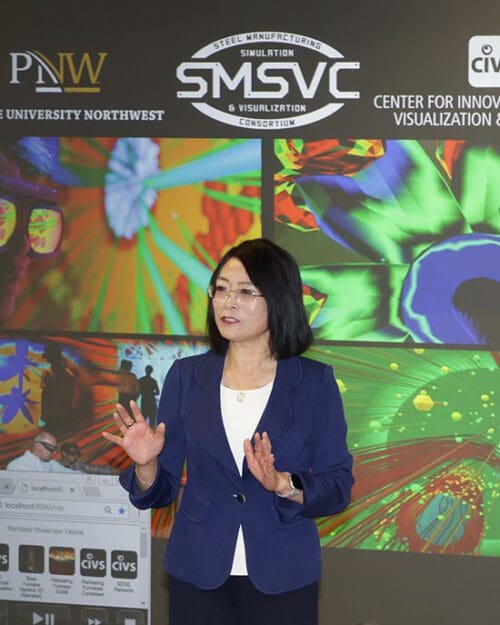
As part of a sweeping federal initiative to reduce carbon emissions and progress toward net-zero emissions by 2050, the DOE awarded $9.96 million to a CIVS project pioneering an industry-scale demonstration of a hydrogen-fired continuous reheating furnace operation.
Purdue University Northwest’s (PNW) Center for Innovation through Visualization and Simulation (CIVS) along with industrial, education, federal, and elected leaders gathered Oct. 11 to recognize a significant grant of nearly $10 million from the U.S. Department of Energy (DOE)’s Industrial Efficiency and Decarbonization Office to support decarbonization research, development, and demonstration in the steel industry.
As part of a sweeping federal initiative to reduce carbon emissions and progress toward net-zero emissions by 2050, the DOE awarded $9.96 million to a CIVS project pioneering an industry-scale demonstration of a hydrogen-fired continuous reheating furnace operation. Partners in the project include ArcelorMittal, Argonne National Laboratory, Cleveland-Cliffs, Gerdau, Linde, Oak Ridge National Laboratory, and the Steel Manufacturing Simulation and Visualization Consortium.
“We thank the Department of Energy, our project partners and PNW leadership for supporting this important project, which is expected to make positive impacts to our region and nation,” said Chenn Zhou, NIPSCO Distinguished Professor of Engineering Simulation at PNW and founding director of CIVS. “My special thanks go to our industry co-principal investigators: Joao Gonzaga, senior director of Engineering, and Kevin Kondrat, improvement facilitator of Rolling Mill at Gerdau, and Joe Maiolo, associate director of Research and Development — Metals Applications, from Linde. Our CIVS faculty and student researchers are excited to begin and are looking forward to collaborating with our industrial and research partners to develop and demonstrate the technology to improve the U.S. steel industry’s global competitiveness and reduce carbon emissions.”
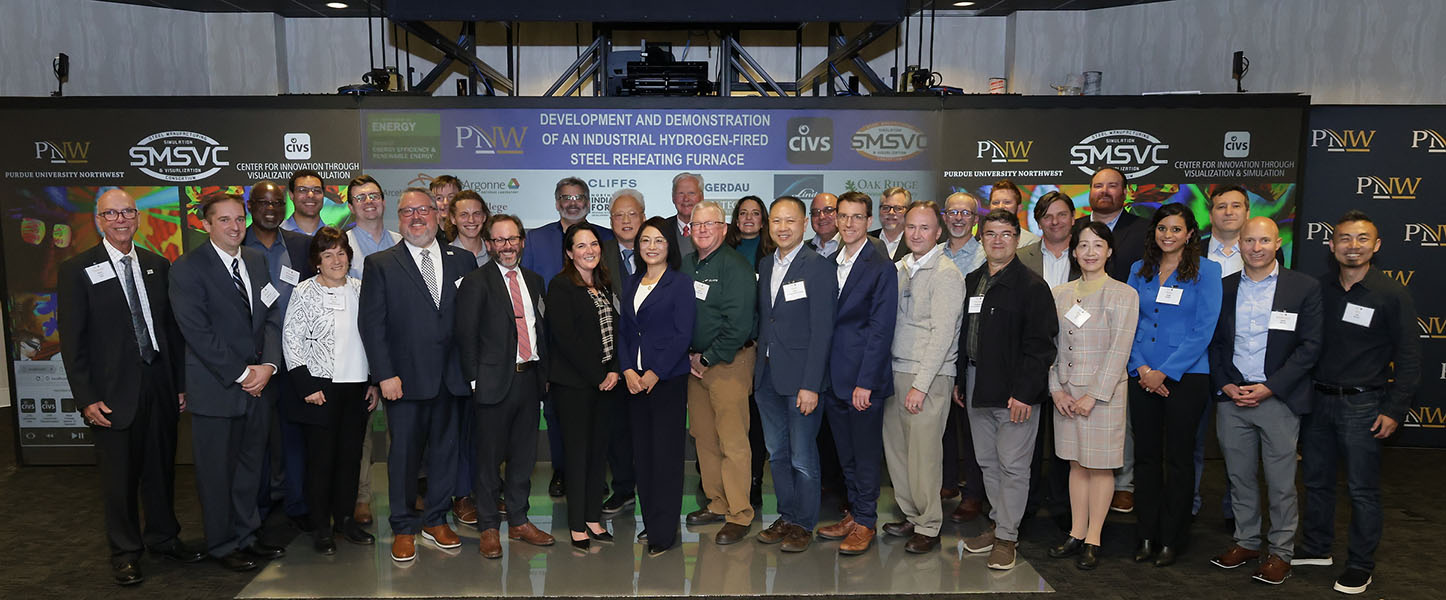
Industrial, education, and federal leaders pose for a group photo inside the CIVS auditorium. CIVS will collaborate with partners Argonne National Laboratory, Cleveland-Cliffs, Gerdau, Linde, Oak Ridge National Laboratory, and the Steel Manufacturing Simulation and Visualization Consortium.
Federal and elected officials praised the project for its potential to improve air quality while increasing efficiencies in the steel producing process.
“I am grateful for the continued leadership of Purdue Northwest’s invaluable Center for Innovation through Visualization and Simulation and this outstanding partnership with the Department of Energy,” said U.S. Rep. Frank J. Mrvan. “Let us continue to build on this momentum to show how Northwest Indiana is the example of how we can create at the same time both a greener future and more economic opportunities.”
“Traditionally, the U.S. industrial sector is one of the most difficult to decarbonize across our economy,” said DOE Principal Deputy Assistant Secretary for Energy Efficiency and Renewable Energy Jeff Marootian. “This project will demonstrate how we can curb those emissions with clean hydrogen, potentially changing the U.S. steel industry forever.”
Let us continue to build on this momentum to show how Northwest Indiana is the example of how we can create at the same time both a greener future and more economic opportunities.
PNW Chancellor Thomas L. Keon noted that CIVS’ work is a major part of the university’s mission as a premier metropolitan university.
“An important part of PNW’s role in Northwest Indiana is to partner on impactful research that will improve the quality of life for its neighboring communities,” Keon said. “This project will contribute to the significant nationwide effort to develop clean energy solutions for major industrial sectors. To be recognized among other leading universities and research centers is a testament to the outcomes provided by PNW’s faculty and the CIVS team.”
This project will demonstrate how we can curb those emissions with clean hydrogen, potentially changing the U.S. steel industry forever.
Cutting edge research for industry solutions
This most recent DOE grant will help CIVS to lead a nationwide collaboration between industry, academia and national labs to pioneer a first-of-its-kind industry-scale demonstration of a hydrogen-fired continuous reheating furnace (RF) operation. It will develop and demonstrate hydrogen-firing in an industry-scale RF that operates with a mix of natural gas and hydrogen at various levels, assisted by simulation, visualization and laboratory experiments, as well as supported by life cycle analysis (LCA) to evaluate energy, economic and emissions benefits. It will also establish roadmap strategies and operation schemes for zero-carbon dioxide emission production in commercial furnaces with a state-of-the-art Integrated Virtual Reheating Furnace. Decarbonization is a process that helps reduce industrial output of carbon dioxide greenhouse gas emissions and transition to alternative energy sources that use less carbon.
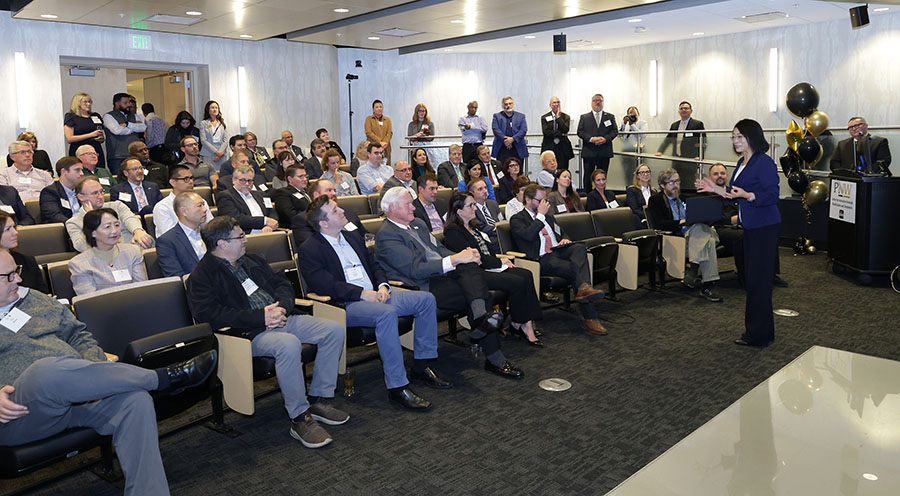
Chenn Zhou, far right, NIPSCO Distinguished Professor of Engineering Simulation and director of CIVS, provides formal remarks during a celebration for a nearly $10 million grant for steel decarbonization research. Industrial, education, and federal leaders gathered for a reception and program on Oct. 11 in the CIVS space.
The reheating furnace is used in hot rolling mills to heat steel for further processing in steelmaking. More than 80 reheating furnaces across the U.S. burn natural gas to reheat semi-finished products, generating 200 kg of carbon dioxide per ton of steel, the majority of carbon dioxide in hot strip mill operations. CIVS’ research aims to show how alternative fuels such as hydrogen could reduce or eliminate carbon dioxide emissions.
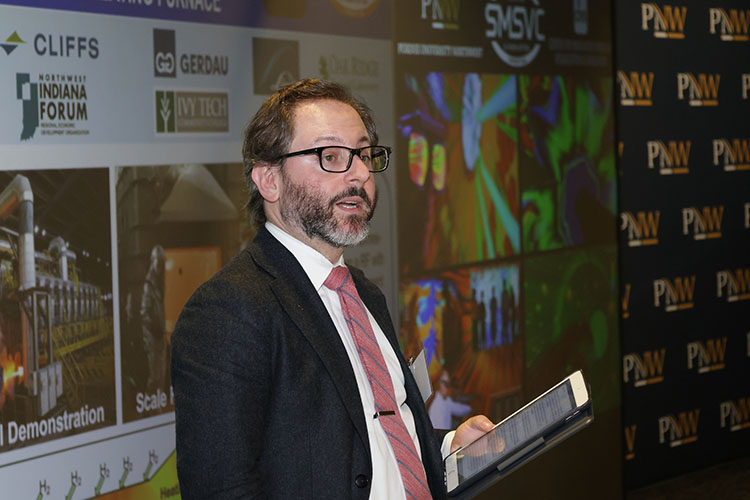
Avi Shultz, director of the U.S. Department of Energy’s Industrial Efficiency and Decarbonization Office, gives prepared remarks in the CIVS auditorium. The DOE provided CIVS and industry partners a nearly $10 million grant for steel decarbonization research.
“CIVS delivers extraordinary outcomes for industry partners through its significant technological tools and impactful research,” said PNW Provost and Vice Chancellor for Academic Affairs Kenneth C. Holford. “The CIVS team repeatedly demonstrates how partnering with high-quality resources at a metropolitan university can move key industrial sectors forward for long-lasting results in terms of their production and the surrounding environment. Its history shows industry partners keep returning to consult with the knowledgeable team members for expertise in optimizing their operations.”
“The project for a hydrogen-fired reheat furnace will be of vital interest to the entire steelmaking industry,” added Ronald Ashburn, executive director of the Association for Iron and Steel Technology.
This project will contribute to the significant nationwide effort to develop clean energy solutions for major industrial sectors. To be recognized among other leading universities and research centers is a testament to the outcomes provided by PNW’s faculty and the CIVS team.
Community impact
CIVS’ project is one of 40 projects across the U.S., selected and collectively supported by $135 million from DOE, aimed at reducing carbon emissions from the industrial sectors and progressing toward a federal goal of economy-wide net-zero emissions by 2050.
CIVS has demonstrated a strong history of research on decarbonization processes in steelmaking operations. CIVS’ research has historically provided valuable solutions for clients that result in more than $40 million dollars in energy-saving solutions. It has received over $37 million in external grants and contracts to develop solutions for industry partners and has collaborated with more than 180 external organizations on over 420 projects since 2009.
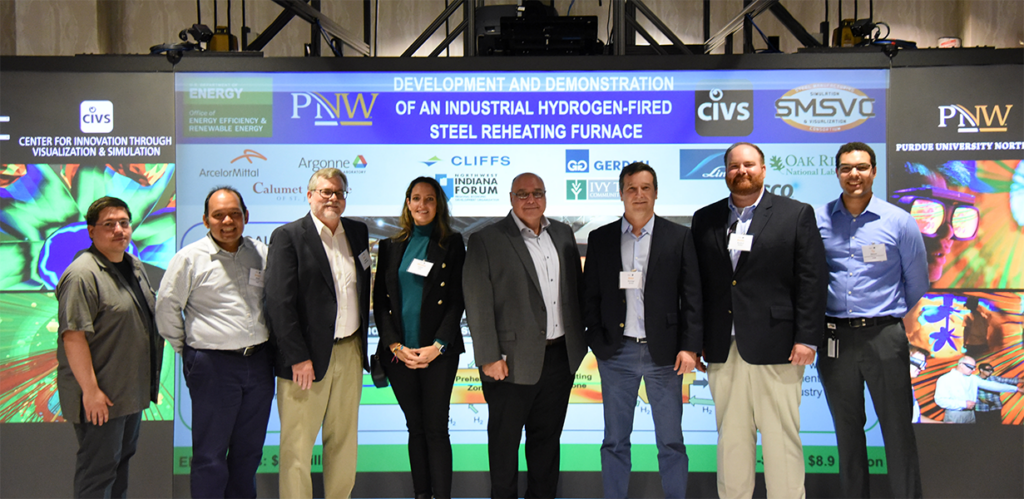
Part of the project team. Pictured from left to right: Nick Walla (PNW), Armin Silaen (PNW, Co-PI), Kurt Johnson (Cleveland-Cliffs), Monica Lupion (Linde), Joe Maiolo (Linde, Co-PI), Joao Soares Gonzaga (Gerdau, Co-PI), Kevin Kondrat (Gerdau, Co-PI), Tyamo Okosun (PNW, Co-PI).
CIVS’ technology uses virtual design to enable enhanced decision-making for the design, optimization and troubleshooting of structures, processes and products. It also provides virtual learning that can be used to enhance industrial education and training. Among its many major grants and projects, CIVS previously was awarded $7 million by DOE for an ongoing effort to develop a next-generation Integrated Virtual Blast Furnace (IVBF) to improve energy efficiency and emissions in steelmaking processes. The IVBF project has developed rapid-prediction models for blast furnace process guidance, a prototype imaging sensor for measuring hot metal casting rates in real time, and machine learning-based indices to help operators and engineers manage stability and understand the current internal states of their furnaces so they may improve efficiency of blast furnaces.
